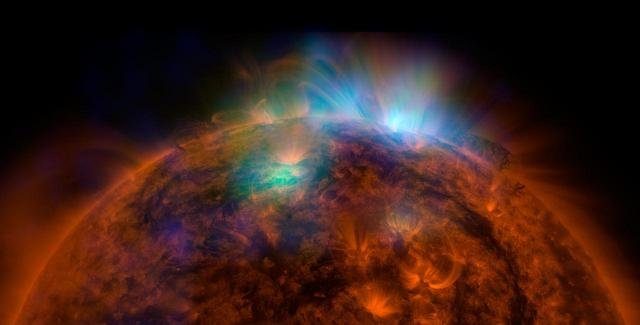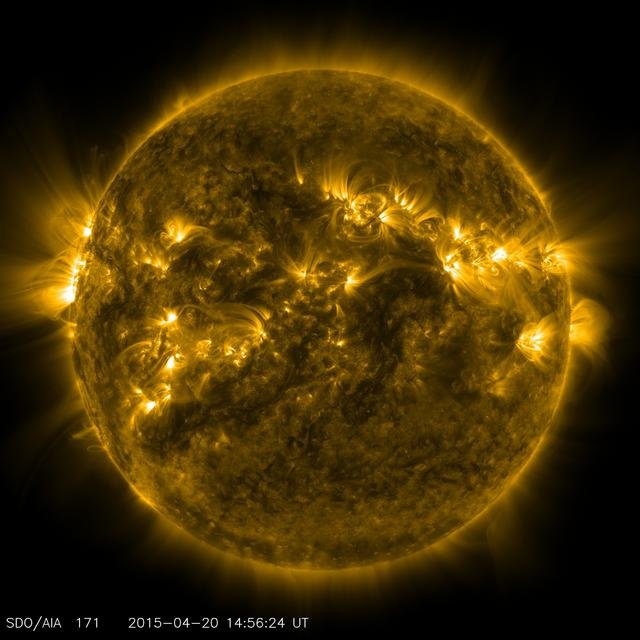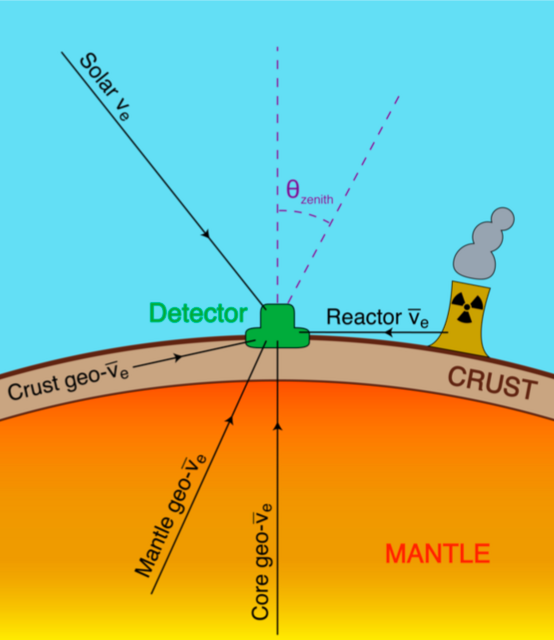When particle physics met geology with ‘geoneutrinos’
Neutrinos are the most stealthy of all elementary particles, and the cornering of their properties is today a key item of the particle physics research program.

[image credits: JPL @ NASA ]
With this article, I want to focus on a specific class of neutrinos that are called geoneutrinos.
Despite their names, geoneutrinos are not neutrinos strictly speaking, but antineutrinos instead (the corresponding antiparticles).
The ‘geo’ part in the name is related to the geophysical origin of these antineutrinos. They are indeed issued from radioactive decays occurring in the curst and mantle of Earth.
The measurement of the properties of these geoneutrinos subsequently gives hope to get more information on the processes that produced them, and on the medium in which this production happened. In other words, geoneutrinos offer handles to get information on the interior of Earth, or to shed light on the composition of Earth.
NEUTRINOS IN A NUTSHELL
Before discussing geoneutrinos, it is interesting to briefly come back to what neutrinos are.

[image credits: NASA/SDO ]
Neutrinos are elementary particles that were introduced in the early days of radioactivity, when physicists were studying specific reactions in which atomic species were decaying one into another.
As we all know, energy conservation is one of the golden rule of modern science.
In the beginning of the 20th century, physicists noticed that in radioactive decays, some energy was disappearing.
It was then postulated that this energy, that cannot have disappeared by virtue of energy conservation, was carried away by some invisible particle species. Those were coined later ‘neutrinos’.
During the next 100 years, neutrinos have been studied through various dedicated experiments. Despite being the most elusive of all particles of the Standard Model of particle physics, we today know that there are three flavors of neutrinos that oscillate into each other through their propagation.
Neutrinos are very weakly interacting and by virtue of these weak interactions with matter, detecting them is damned hard. However, we many experiments dedicated to neutrino studies can do it.
Neutrino interactions with matter are rare, but not non-existent. Therefore, with a detector that is large enough and by waiting a sufficiently-long amount of time, we have something to play with.
GEONEUTRINOS
Geoneutrinos are a special class of electronic neutrinos. Let us call them geoneutrinos although strictly speaking, those guys are the antimatter counterpart of the neutrinos, i.e., the antineutrinos.

[image credits: Roy Kaltschmidt (public domain)]
These antineutrinos are produced inside Earth (in Earth’s crust and mantle), from decays of three radioactive species: potassium (40K), uranium (238U) and thorium (232Th).
Those three atomic elements release an important amount of energy through their radioactive beta-decay into lead (for uranium and thorium) or calcium (for potassium), alpha particles, electrons and the antineutrinos that we are interested in.
This energy partially contributes to the heat flux emitted by the surface of the planet, and is called radiogenic heat. The derivation of the radiogenic heat contribution to the total terrestrial surface heat flux is important to get information on the possible ways in which our planet was formed, on plate tectonics or to test the different models proposed to explain the origins of the magnetic field of the planet.
Since the nuclear reactions behind geoneutrino production are perfectly known (those are the reactions above-mentioned), geoneutrino flux measurements is the thing to do to get insights on the radiogenic heat released during geoneutrino formation.
But geoneutrino detection is not trivial…
DETECTING GEONEUTRINOS
The phenomena ongoing in the interior of our planet generates a flux (at the level of the Earth surface) of a million of neutrinos per cm2 per second. However, neutrinos interact so rarely with matter (weak interactions are… well… weak) that the detection of a single of these neutrinos is challenging (they often just going through the entire planet undisturbed).
Such a detection could occur through inverse beta decay, when a neutrino hits a proton being part of normal matter. This then produces an electron and a neutron, both of them being detectable. Whilst there is no chance for potassium geoneutrinos to trigger such a reaction (they are not energetic enough), a substantial amount of the produced thorium geoneutrinos and uranium geoneutrinos can be detected.

[image credits: ArXiv ]
For potassium, other techniques are however being developed, relying on neutrino-electron scattering.
Detection implies that one needs to make sure to control the background, which requires shielding (to be protected from cosmic phenomena), as well as to account for unwanted solar neutrinos and man-made neutrinos originating from nuclear reactors.
Two of these detectors have so far successfully managed to measure geoneutrino fluxes, Borexino (Italy) and KamLAND (Japan).
A wealth of results that has been harvested.
It includes, among others, the measurement of the thorium-to-uranium ratio, a confirmation of the geological expectation with particle physics, the separation of the Earth mantle/crust contributions, the test of the presence of a georeactor inside the innermost core of Earth (null result so far) and even more.
SUMMARY AND TAKE-HOME MESSAGE
I discussed today geoneutrinos, i.e. neutrinos that are generated in the interior of Earth and that reach the surface of the planet undisturbed. The corresponding production mechanismss rely on the presence of radioactive uranium, thorium and potassium inside the Earth mantle and crust. The decay of these radioactive species indeed induce a surface flux of millions of neutrinos per second per cm2.
Two experiments has so far managed to measure geoneutrino fluxes, controlling backgrounds involving other neutrinos as well as cosmic rays mimicking the behavior of the neutrinos. Those experiments have allowed particle physics to contribute to geology by checking geological models, investigating potential sources for the Earth magnetic field, studying the properties of the mantle and crust of Earth, etc.
Moreover, the measurement of the geoneutrino contributions to the Earth heat flux will also allow to evaluate which fraction of the heat is a left-over from the time Earth had been formed, and which fraction is still produced by phenomenas on-going in the inside of the planet.
New experiments are about to start, and the expected more precise results have the potential to start disentangling various options for the geological modeling of Earth! Multidisciplinarity at work!
STEEMSTEM
SteemSTEM aims to make Steem a better place for Science, Technology, Engineering and Mathematics (STEM). For more information about the SteemSTEM project, make sure to follow steemstem on steemstem.io, steemit, facebook, twitter, and instagram to always be up-to-date on our latest news and ideas. Please also consider to support the project by delegating to @steemstem for a ROI of 65% of our curation rewards (quick delegation links: 50SP | 100SP | 500SP | 1000SP | 5000SP | 10000SP).
I know that this is a silly question to ask, but I thought Potassium had an atomic number of 19. How does it get to 40?
You are correct. 40 is the number of nucleons: 19 protons (the atomic number) and 21 neutrons .
Ah... yes.. very good. So, then a follow up question: Could geoneutrinos be produced from within a living creature, as most of us have some potassium scattered about inside of us?
Well, is biomass not considered a part of the planet? Or at least the "Crust?"
Is decomposed plant (life) matter, such as soil, not factored into the equation? Cause that's a whole lotta mass. And if such inanimate matter is part of the Earth, then why aren't living things? I'm not trying to split hairs and be a jerk, either. I was considering spacetime and the Earth's gravity-well.
I know it's a silly question, but I killed my television years ago so I could spend more time thinking about this stuff. It's fun. :)
In fact, one considers the crust and the mantle, but not any living beast that could walk on the surface. It is just a matter of definition.
To answer the question about neutrino production in humans or in any other animals, I don't know. Neutrinos arise from nuclear reactions, and there are very small rate of such reactions occurring inside the bodies. I would then imagine than the flux is negligible compared to the rest. But I have nothing to back up my claim. Sorry.
However, if the flux would be large, one should have already seen it in experiments.
Cool. Thanks for responding. I just wanted to see if there was more to it. Probably could have looked it up, but what is engagement for? :)
Any question is a good question! At least from my standpoint. Thanks for having passed by and not hesitated to ask yours (I also had to do some research to try to get an answer, which is always a positive outcome) :)
I reckon from the perspective of neutrinos, we are indeed part of the Earth.
I don't think that's a 'jerk' observation, but a bit out of the box, and that's amongst the most valuable, at least to me.
Thanks!
There is nothing wrong with the question. I just didn't answer because my online time is not 100% this week.
I have proposed an answer, but I am not sure. I don't know everything ;)
No they can't, as by definition, a genoneutrino is an antineutrino produced inside the planet. If an antineutrino is produced elsewhere, it is not a geoneutrino.
Very well-explained and interesting artice! I'm curious though, are geoneutrinos the only kind of antineutrinos?
The wording 'geoneutrinos' denote both the neutrinos and antineutrinos that are produced from the decay of the radioactive elements inside Earth. However, there is only a tiny fraction of neutrinos coming from rarer 40K decays. Antineutrinos hence represent more than 99% of all geoneutrinos.
I was wondering, can geoneutrinos be produced in a controlled environment too? Like in a lab, or a particle collider. Or is it exclusively produced inside the earth's core?
Hope I'm not asking a stupid question?
By definition, a geoneutrino is a neutrino produced inside Earth. While weone can produce neutrinos by (many) other means, those neutrinos are not geoneutrinos.
Another good post.
Does this mean that these geoneutrinos would annihilate with normal neutrinos produced by other natural reactions?
Do neutrinos react with other neutrinos?
Posted using Partiko Android
Thanks for the nice comment!
Those reactions are possible (weak current via a Z-boson exchange) but the chances the neutrinos interact with surrounding protons or electrons are larger (an this is what is used for detection).
Waiting to see what the new experiments would unravel. The more we learn, the more we realised there are loads of stuff out there that we don't know :)
Merry Christmas and happy holidays
Also, those new experiments may be places for anomalies. Observing those would be exciting (and I really hope that we will have some, somewhere, at some point).
Merry Xmas to you @greenrun!
Thank you :)
I had read about the Japanese laboratory. A work of incrible engineering. I did not know about Italy
SALUDOS DESDE VENEZUELA
SALUTATIONS DU VENEZUELA
Greetings from Venezuela
Yes, those detectors are amazing pieces of technology! Thanks for passing by.
Congratulations @lemouth! You have completed the following achievement on the Steem blockchain and have been rewarded with new badge(s) :
Click here to view your Board
If you no longer want to receive notifications, reply to this comment with the word
STOPDo not miss the last post from @steemitboard:
Hi @lemouth!
Your post was upvoted by Utopian.io in cooperation with @steemstem - supporting knowledge, innovation and technological advancement on the Steem Blockchain.
Contribute to Open Source with utopian.io
Learn how to contribute on our website and join the new open source economy.
Want to chat? Join the Utopian Community on Discord https://discord.gg/h52nFrV